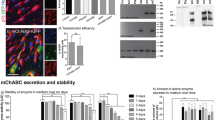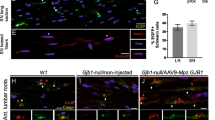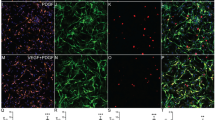Abstract
SCHWANN cells can remyelinate axons normally myelinated by oligodendrocytes, after either primary demyelination1–3 or suppression of myelination by X irradiation at the time of myelination4,5. It has been suggested that the glial limiting membrane normally inhibits Schwann cell invasion of the CNS (ref. 2) and its reformation inhibits uncontrolled invasion by Schwann cells once this phenomenon has been initiated1,2. The Schwann cells in these situations are thought to arise from the nerve roots. I undertook experiments to determine whether it is possible to suppress remyelination following primary demyelination in an experimental animal. If so the resulting demyelinated axons would be similar to those present in the multiple sclerosis plaque, that is they would remain demyelinated unrepaired by glial or Schwann cells. Using such a lesion it would then be possible to establish if Schwann cells obtained from a source outside the central neuraxis would remyelinate these axons. In the past, attempts at transplanting peripheral nervous tissue into the central nervous system have shown very limited invasion of peripheral elements into the neuropil of the CNS (refs. 6,7) and it was hoped that the presence of large numbers of demyelinated axons would act as a stimulus for Schwann cell invasion8. In addition, intraspinal injections of lysolecithin facilitate Schwann cell invasion of the CNS from local sources2,9. By abolishing this intrinsic Schwann cell remyelination potential and by substituting an extrinsic source of Schwann cells it might be possible to determine if persistently demyelinated axons in the CNS, similar to those in multiple sclerosis plaques, can be repaired by outside interference. I report here the preparation of areas of demyelination in rats and cats which remyelinated only in the presence of added Schwann cells.
This is a preview of subscription content, access via your institution
Access options
Subscribe to this journal
Receive 51 print issues and online access
$199.00 per year
only $3.90 per issue
Buy this article
- Purchase on Springer Link
- Instant access to full article PDF
Prices may be subject to local taxes which are calculated during checkout
Similar content being viewed by others
References
Blakemore, W. F. J. Neurocytol. 4, 745–757 (1975).
Blakemore, W. F. J. Neuropath. appl. Neurobiol. 2, 21–39 (1976).
Harrison, B. M., McDonald, W. I. & Ochoa, J. J. neurol. Sci. 17, 293–302 (1972).
Gilmore, S. A. J. Neuropath. exp. Neurol. 22, 294–307 (1963).
Blakemore, W. F., Patterson, R. C. J. Neurocytol. 4, 573–585 (1975).
Le Gros Clarke, W. E. J. Anat. 77, 251 (1942).
Koa, C. C. Expl Neurol. 44, 424 (1974).
Wood, P. M., Bunge, R. P. Nature 256, 662 (1975).
Blakemore, W. F., Eames, R., Smith, K. & McDonald, W. I. J. neurol. Sci. (in the press).
Author information
Authors and Affiliations
Rights and permissions
About this article
Cite this article
BLAKEMORE, W. Remyelination of CNS axons by Schwann cells transplanted from the sciatic nerve. Nature 266, 68–69 (1977). https://doi.org/10.1038/266068a0
Received:
Accepted:
Published:
Issue Date:
DOI: https://doi.org/10.1038/266068a0
This article is cited by
-
Cell replacement therapy with stem cells in multiple sclerosis, a systematic review
Human Cell (2023)
-
Cell Therapy for Multiple Sclerosis
CNS Drugs (2017)
-
Pluripotent Stem Cells for Schwann Cell Engineering
Stem Cell Reviews and Reports (2015)
-
Self-assembling peptide nanofiber hydrogels for central nervous system regeneration
Frontiers of Materials Science (2015)
Comments
By submitting a comment you agree to abide by our Terms and Community Guidelines. If you find something abusive or that does not comply with our terms or guidelines please flag it as inappropriate.



